Trading cards go to college
The summer of ’95 – Batman Forever dominated at the box office, Waterfalls was the song you just could not escape from, and baseball cards were at a now-unimaginable peak with six (six!) licensed manufacturers. Cards had grown up a lot since the junk wax boom that started in the ’80s. With cereal box printing technology long abandoned (since 1991, at least), new premium card formats were popping up everywhere. Full color, full gloss, foil stamping, holograms, die-cuts, and even refractors were all over the market. On top of that, trading cards had grown beyond just collecting and were moving into the realm of gaming. The hobby had matured.
As for me, I had limited time and limited funds. Like the previous summer, Scout activities ate up most of my free time. Only, instead of scrambling up mountains, I was scrambling to finish the requirements for Eagle. I still had time before I aged out, but I had a hard stop on August 18. I was heading off to college the next day. With that, my card collecting would be winding down, eventually coming to a halt with a few packs of UD3 in 1997. But little did I know that cards would be waiting for me at college orientation.
Orientation
The scene – Worcester Polytechnic Institute, New Student Orientation 1995. Hundreds of new students were arriving on campus well ahead of the start of classes to get settled into their new homes. Five days of activities were planned to help them acclimate to college life and get to know each other. Students were broken into orientation groups, each led by, as you might expect, an Orientation Leader. Once the academic business of sorting people into the proper level of Calculus and Physics classes was settled, it was on to the challenges. Orientation was now a competition.
And this is about when people started to realize that participation in orientation was optional. Sure, you could go and hang out with a bunch of strangers and hear all about their particular nerdy interests (if you didn’t already know about Doctor Who or any number of role playing games, you would now…), but have you seen this internet thing? E-mail won’t read itself…
So, yeah, most of us were such colossal dorks that we kept going to orientation even when it became clear that there was nothing to gain from it. And that’s when they broke out the cards.
Cards? WPI isn’t exactly a name that comes to mind when you think about trading cards. If you read the fine print, you might have seen WPI on the list of colleges Panini signed a licensing deal with a few years ago (and extended last month). As far as I can tell though, nothing has come from that in terms of WPI.
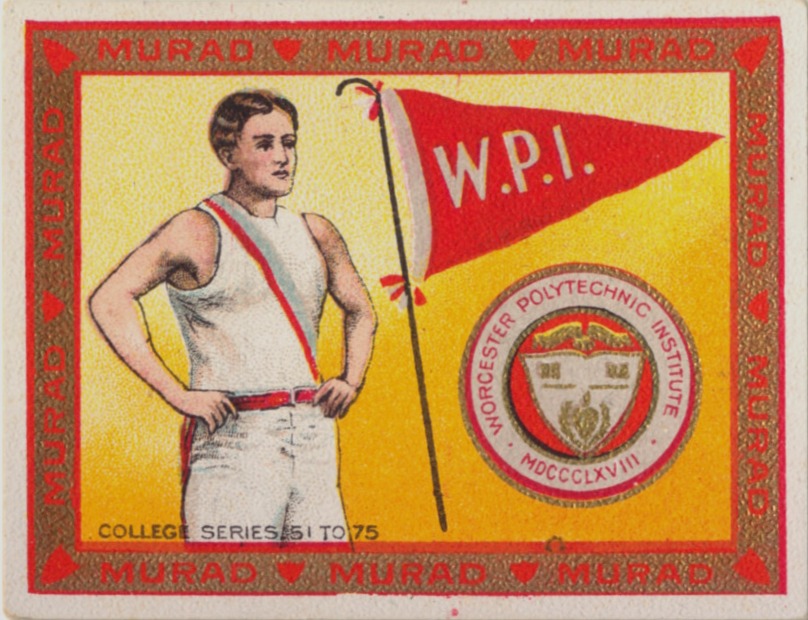 In fact, the only WPI trading card I have ever seen for sale is the above 1910 tobacco card. The cards given out in 1995 weren’t sports cards; instead, they were intended to help new students familiarize themselves with the school.
In fact, the only WPI trading card I have ever seen for sale is the above 1910 tobacco card. The cards given out in 1995 weren’t sports cards; instead, they were intended to help new students familiarize themselves with the school.
WPI: The Trading
WPI is one of the more progressive institutions of higher learning, having done away with things like prerequisites and detailed grading (though they did have to roll back the grading part a bit when hiring managers couldn’t figure out what “Acceptable” was supposed to mean). Using trading cards as part of orientation was such a novel idea at the time that it got international media attention (from online outlets that have since gone offline). The set featured various people, places, and activities that would help students to understand what WPI was all about. Assuming anyone read the backs of the cards (Narrator Voice: They did not).
Everyone got a hinge box (hinged on the short side for some reason) with 50 copies of one card and a checklist for the 50-card set. The challenge: trade with other students to complete the set. The complete set was worth a point on the scavenger hunt and that somehow factored into the overall competition that everyone forgot about long before classes started. The game was on.
If you did the math, with 600 or so of us spread across a couple dozen (23 according to the instructions) orientation teams, every team would have to have 2 or 3 different cards. So our first order of business was diversifying our holdings before heading out. We had a plan and we were off.
But we didn’t have connections. Well-connected students made short work of the bulk of the set, while most of the rest didn’t even bother with the exercise. For everyone else, it was a slow march to failure. Despite being one of the most avid collectors there, my experience with trading largely ended in 1986. I was out of my element with something that was totally my element.
Cage Ball
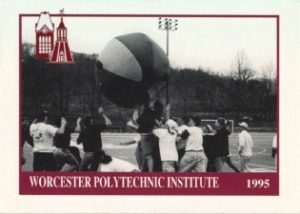 By dinner time that evening, desperate card traders were confronting everyone who passed through the Wedge. But there was only one card everyone was after – Cage Ball. Some people needed one or two others, but nobody needed the cards you had. At least, nobody who was still trading. Demand for Cage Ball was spiking but the supply was nowhere to be found. Speculation was that one group didn’t get their cards, but that couldn’t be confirmed. Trading had come to a halt.
By dinner time that evening, desperate card traders were confronting everyone who passed through the Wedge. But there was only one card everyone was after – Cage Ball. Some people needed one or two others, but nobody needed the cards you had. At least, nobody who was still trading. Demand for Cage Ball was spiking but the supply was nowhere to be found. Speculation was that one group didn’t get their cards, but that couldn’t be confirmed. Trading had come to a halt.
An AP story captures some of the fallout but omits the key detail – the only orientation group with Cage Ball cards received their cards a day late. Even though the cards were no rarer than any of the others (and, in fact, were probably more common once cards held by inactive traders were taken out of the population), the brief delay in circulation made their value spike.
Administrators were hoping that trading cards would teach the new students something about the school while encouraging the students to interact. On the latter, results were mixed; a brief burst of frenzied trading followed by a small group of students essentially having a bounty on their heads probably wasn’t what they had in mind. As for the former, students did learn something, but it was a lesson in economics and psychology.
The Rest of the Set
It’s safe to say that the 1995 WPI Orientation set had little lasting impact on the school, the students, or the world of collecting. Outside of that one AP story and some mentions in the student newspaper, there’s no record of these cards online. There isn’t even a single picture I could find. So let’s change that. While I never finished a set, my roommate did and gave it to me. It was the least he could do after I literally talked him off a ledge (pay attention to life’s psychology lessons, folks) and later helped him move at the end of the year (an epic tale involving a dead squirrel and a stolen phone, but that’s a story for another day).
Card Design
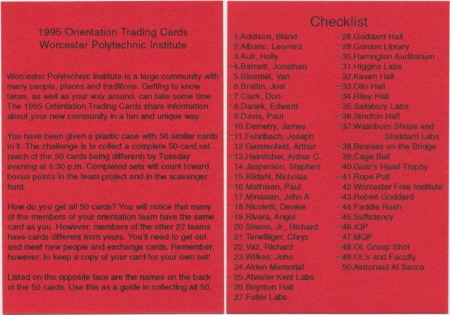
Each box of 50 cards came with a checklist and instruction sheet printed in black text on a piece of red paper. While the checklist is numbered, the cards are not and the names on the checklist don’t exactly match all of the names on the cardbacks. Could have used a copy editor…
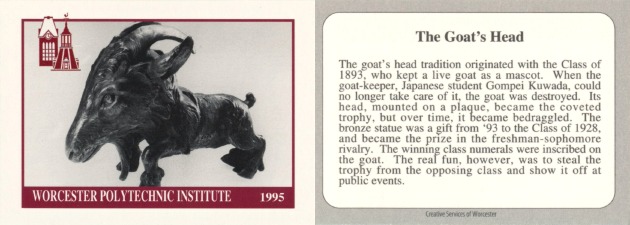
The card design is based around the school colors of crimson (that’s what they call maroon at WPI) and gray. A photograph (black and white on 40 cards, color on 10) is set in a red border with the two towers logo in the upper left corner and a banner with “WORCESTER POLYTECHNIC INSTITUTE 1995″ at the bottom. Borders are large and white. Overall, the design somewhat resembles 1991 Donruss Studio. The backs feature a description of the subject of the card in black text on a white background with a gray border. The cards are credited to Creative Services of Worcester and no other printing or licensing details are present. Sizing is inconsistent, roughly within +/- 1/32” of standard trading card size.
Selected Cards
Goat’s Head Trophy
As for the content of this particular card, it’s a bronzed goat’s head on a tiny body that has been at the center of WPI’s class rivalry traditions for nearly a century now. At least, this is the first one. By 1995, it was in pretty bad shape and a replacement had been commissioned. But before the replacement could be introduced by the administration, it was stolen by members of the class of ’96. After that, I don’t remember much of what happened to it. I vaguely remember something about it turning up in the hands of alumni. Traditions didn’t seem to be that significant during my time there and most of what I know about them came from these cards…
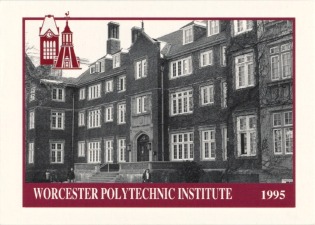 Riley Hall is the oldest residence hall on campus and was my home for three years. As with any old building, it has its quirks and oddities. Rooms were a mix of singles, doubles, triples, and three-room quad suites, with the bulk being triples (then unusual at WPI except when there was a housing shortage the next year and most doubles in other buildings became triples). This year, though, campus housing was below capacity, leaving some beds or entire rooms empty.
Riley Hall is the oldest residence hall on campus and was my home for three years. As with any old building, it has its quirks and oddities. Rooms were a mix of singles, doubles, triples, and three-room quad suites, with the bulk being triples (then unusual at WPI except when there was a housing shortage the next year and most doubles in other buildings became triples). This year, though, campus housing was below capacity, leaving some beds or entire rooms empty.
Riley boasted a unique mix of flora and fauna. The distinctive “ivy” seen outside the quads was mostly a nuisance, interfering with windows and dropping messy fruit all over the sidewalks. Inside, Rileybugs made their homes in the walls and freaked out the more squeamish residents. These white millipede-like bugs, ranging from one to several inches in length, are said to exist nowhere else on Earth.
Amenities were sparse, with dorm rooms on all four upper floors and only the basement (as seen from the quad, ground floor from the other side) available for other uses. Unlike other nearby dorms, Riley didn’t feature a dining hall, mail room, bookstore, or even a laundry room. What did it have? Pizza! Gompei’s, WPI’s only on-campus pizza place, was located in Riley’s basement. Well, more adjacent to it. And you still had to walk outside to get in most of the time. But it was still convenient and would take the points that kept accumulating on your card for payment.
The bulk of the actual interior of Riley’s lowest level was taken up by Riley Commons, which went unused most of the time, acting as a seating area for Gompei’s and presenting locked doors to prevent passage from the student activity offices on one side of the building to the student activity offices on the other side. Gompei’s and the student activity offices would relocate to the Campus Center several years later.
Easter Egg: I placed two rainbow Apple Computer window cling stickers on windows in Riley back in the ’90s. As of a little over a decade ago, they were still there. Google Street View can’t give me a clear enough view, so I don’t know if that’s still true. But maybe?
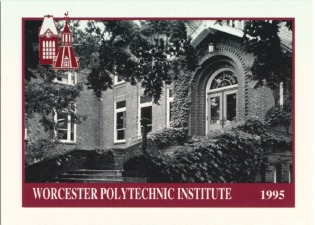 My second home at WPI, Atwater Kent Labs was built in 1907 as the first building in the US dedicated to the study of electrical engineering. Originally built around a cavernous open lab and featuring a trolley car and huge control panel (a portion of which currently adorns the wall in the lounge), it has been upgraded and modified throughout the years to meet the needs of the curriculum. And to provide undergrads and grad students alike plenty of windowless labs to ceaselessly toil in on their way to eventually receiving a degree and earning their freedom.
My second home at WPI, Atwater Kent Labs was built in 1907 as the first building in the US dedicated to the study of electrical engineering. Originally built around a cavernous open lab and featuring a trolley car and huge control panel (a portion of which currently adorns the wall in the lounge), it has been upgraded and modified throughout the years to meet the needs of the curriculum. And to provide undergrads and grad students alike plenty of windowless labs to ceaselessly toil in on their way to eventually receiving a degree and earning their freedom.
What made this building truly special though wasn’t the equipment or the decorations. It wasn’t even the pile of brand new networking cable in the basement leftover after the re-cabling in 1999 that was free to anyone who wanted 50′ bundles of cable that I may still have some of in a box in my basement. No, it all came down to the people. Atwater Kent was a gathering place for EEs, with the IEEE lounge selling coffee and donuts every weekday morning, HKN hosting a pizza lunch every Friday, and the department frequently gathering there on Fridays to head over to Ralph’s for happy hour. Undergrads, grad students, and professors all interacted as equals, making sure everyone was welcome. Even stray CS majors.
James Demetry
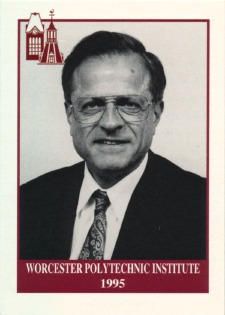 Professor Demetry taught my first Electrical Engineering course at WPI. At the beginning of the course, he proclaimed to all of us “You will get a Master’s Degree.” Five years later, he was proven correct, in my case, at least.
Professor Demetry taught my first Electrical Engineering course at WPI. At the beginning of the course, he proclaimed to all of us “You will get a Master’s Degree.” Five years later, he was proven correct, in my case, at least.
Denise Nicoletti
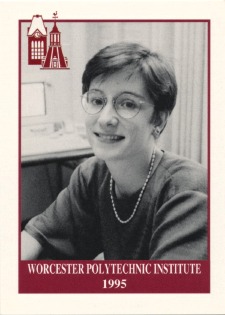 I never had a class with Professor Nicoletti, but I did have a job as a Senior Tutor with her once. That brief experience showed me firsthand her amazing talent for complex mathematics and her passion for teaching. She made it her mission to use her knowledge and skills to educate others, particularly women, co-founding Camp Reach and starting Women in Electrical and Computer Engineering.
I never had a class with Professor Nicoletti, but I did have a job as a Senior Tutor with her once. That brief experience showed me firsthand her amazing talent for complex mathematics and her passion for teaching. She made it her mission to use her knowledge and skills to educate others, particularly women, co-founding Camp Reach and starting Women in Electrical and Computer Engineering.
Nicoletti remained a fixture on campus even when pregnant with twins, facing challenges that are unique to women and using her experiences to help others who would face them in the future. She never stopped looking for ways to improve education and was an inspiration to all who knew her.
On July 22, 2002, Denise Nicoletti was driving with her twin sons when a driver heading in the opposite direction fell asleep at the wheel, crossed over the median, and collided with her head-on. She was killed and her sons were injured. The entire WPI community suffered a profound loss.
Sadly, this was not the first senseless tragedy involving someone I knew from WPI. But the rest is best left for another time.
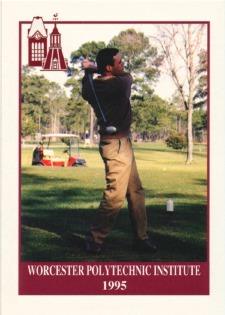 If there was a title of “The Cool Professor,” Rick Vaz would get it. Just look at the back of his card:
If there was a title of “The Cool Professor,” Rick Vaz would get it. Just look at the back of his card:
“Director of WPI Venice Project Center”
“Hobbies: Golf, Softball, Wine, Cigars, Cooking”
And that’s not to mention being the advisor to WPI’s student branch of IEEE. While largely hands-off in that role, he was always willing to help out to keep things running smoothly. So when I needed one more member of my MS thesis committee, he was an obvious choice. On my last trip to WPI as a student, one of my final tasks was to get his signature on my thesis. Somehow, I never thought to get any of these cards signed though. With his signature, my time as a WPI student came to an end.
Notable Omissions
50 cards may seem like a lot, but this set’s checklist is still a bit lacking. Here are nine more that deserved consideration.
Buildings
At first glance, the set seems to be fairly comprehensive when it comes to important buildings (unless you’re a fan of dorms…). But there are a few more worth noting.
Alumni Gym
As far as academic buildings go, the set has everything covered, with one exception (well, two if you count the Project Center, but that place had all the charm of an abandoned building, so let’s just ignore it). Alumni Gym, Harrington Auditorium’s less attractive older sibling, is at least deserving of mention. While it may not have had the large interior space of its neighbor, it was a unique structure with a multitude of quirks, from the occasionally-functional bowling alley and non-regulation size pool in the basement to the tiny running track in the attic.
Home to formal events and alumni gatherings, Higgins House may be little more than an interesting curiosity to incoming Freshmen. But its grounds were once a bit more expansive and included a forested area frequented by LARPers late at night (now the site of the Campus Center). If the point of the set was to demystify parts of the WPI community and experience, Higgins House should have been at the top of the list.
Skull Tomb
Speaking of mysteries, there is one part of campus that is shrouded in mystery to all but a select few. Skull, WPI’s not-so-secret honor society, has the exclusive use of the short-lived Magnetic Lab. Specially constructed using only non-ferrous materials, vibrations from streetcars and later interference from electric lights rendered the lab useless for its intended purpose. Other usage, including Robert Goddard’s experiments with rockets, followed before it was handed over to Skull in 1921. Rechristened the Skull Tomb, its contents for the past century have been a closely-guarded secret.
People
While everyone probably has a favorite professor who didn’t make the cut, professors already account for almost half of the set. It would be easy to pad out the set to reach any desired size by adding more professors and administrators, so let’s focus on historic figures instead.
While the building named after him made the list, Atwater Kent himself did not. A Freshman in the Class of ’99 exactly 100 years before these cards were made, it would have made sense to give him a card. Though I suppose the administration probably hoped that members of the second Class of ’99 would stick around a bit longer; Kent left after one semester, came back again the next year, and then left again after one more semester to focus on his business.
A more contemporary example of a famous inventor from WPI would have been Dean Kamen, now best known for the Segway. While the Segway was still several years out at the time, Kamen had done enough to earn an honorary doctorate from WPI in 1992 (as with Kent, he left the school without a degree to focus on his business). I’m starting to sense a pattern here…
Now, I know what you’re thinking – “Did anyone who ever did anything noteworthy actually graduate from WPI (other than Robert Goddard, who has a card)?” If you’re fond of literally anything electronic from the past century or so, then the answer is a resounding “Yes.” Harold S. Black, father of the negative feedback amplifier, had the decency to complete his undergraduate education before going off and coming up with one of the most important innovations in the history of electronics. I’d say that’s worth immortalizing in cardboard.
Traditions
I have one big problem with the traditions shown in this set – they are largely irrelevant to modern students. Or at least, that’s how it seemed in the late ’90s. With a focus on the Freshman-Sophomore rivalry (which I think our class largely opted out from), the set missed the traditions that students were actually likely to encounter.
QuadFest
Sure, only the third QuadFest was held in 1995 before this set was produced, but if you can include traditions that hadn’t been relevant in decades, why not include one that would continue to be relevant in the future (it’s still on the official list of WPI traditions, now called SpringFest)? One last weekend-long blast before the march to finals, QuadFest saw the campus transformed into a massive entertainment venue, centered on the Quad, as you would guess. The New Voices student theater festival also ran concurrently with QuadFest, as did the 100th anniversary celebration for WPI’s Electrical Engineering Department in 1996.
Career Fair
While not technically a tradition, the annual career fair presented a valuable opportunity for students to interact with a variety of employers in the region, whether they were seeking upcoming employment or not. Though, considering that the Career Fair was the subject of my most popular articles for the student newspaper, I may be a bit biased. With the Career Fair taking place less than a month after orientation, the card set would have been the perfect opportunity to bring it to the attention of incoming Freshmen.
Computer Carry
I’ll see your “Freshmen forced to cross West Street at Earle Bridge” and raise you “Freshmen forced to carry their computers across campus to the CCC to have them configured to work on the network.” It may seem as archaic as beanies now, but the WPI network was once anything but plug-and-play (unless you had a Mac). As such, configuration had to be left to the professionals and they did not make house calls. Move-in day was inevitably followed by the sight of students lugging heavy beige boxes across the quad, down West Street, around Salisbury Labs, and down into the depths of Fuller. Think about that the next time you complain about your ultralight laptop or tablet having trouble connecting to the Wi-Fi.
Comments are closed.